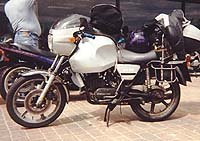Ride, Captain, Ride: The 1997 Iron Butt Rally
For those of you who think the customized version of personal torture known as the Iron Butt Rally is a leisurely tour of the USA -- or if you aren't familiar with what it entails -- well, chug eight cups of coffee to get in the properly wired mood and read on, because you've got a rude awakening ahead. The personal bravado of these long-distance enthusiasts is bound to make you feel a bit soft in the saddle on that next weekend outing slicing a little wind Like its manually powered cycling cousin, the Tour de France, the Iron Butt Rally defines the limits of how long an individual can sustain themselves straddled atop an internal combustion engine balanced by two wheels. Initiated in 1984, the IBR has seen its legions grow from the original 10 starters to the 91 riders registered for this year's suburban Chicago starting line. A finishing rider can easily expect to ride, virtually non-stop, the four corners of lower 48 United States and rack up some 10,000 to 12,000 hard-won miles over 11 days, across often unremarkable and unforgiving terrain. Points are accumulated against mileage and time. Since nothing besides peer recognition and personal pride is at stake, IBR participants must brush aside the glittery tinsel of money and glamour and jump into the trenches of individual challenge and accomplishment.
The Iron Butt Association handles the awards process diplomatically. Two rally participants, Manny Sameiro and Dwight Hageman, both crashed their bikes beyond repair, purchased replacements and finished the event on time. They finished last and next-to-last, and they both received trophies awarding them for their unprecedented efforts. This has never happened before in the history of the IBR, but now it occurred twice in the same year. Manny Sameiro was the first to do it, on the first leg of the ride, and so the award was appropriately branded as "The Manny Award." Would you name an award after this man? But winning that small accolade from his peers wasn't easy. "Once I dumped the bike and went to the hospital I was trying to find a way home. I had basically given up at that point," said Sameiro. But his inability to find a rental car forced him to stay overnight in Maine. "It was during those next twelve or so hours that I decided that quitting would be just too easy. So I woke up the next morning and that's when I decided to get a bike. It wasn't an immediate decision for me." Sameiro started with a 1986 Suzuki Cavalcade, and finished with a 1983 Honda Shadow 500cc V-Twin.
Sometimes it's those little unanticipated occurrences that force a rider to be resourceful. Marty Jones of San Angelo, Texas found that to be the case on his Kawasaki Voyager. "I was out to win, and eight hours into the rally, I busted a fuel pump in Cleveland," said Jones. "It was too late to get parts, and too far away to replace the part and make the first bonus or make the first checkpoint." As a result, he failed to make that checkpoint in adequate time after making the repair himself with an aftermarket automobile fuel pump.
"It essentially put me out of competition with anybody, except myself. I finished the rest of the ride figuring it was just a personal thing, and beat people who made it to one of the checkpoints. And I did." The determination to find his way out of a compromising situation evolved into a competitive edge. "When I got to Florida I was down 7,000 some-odd points, and I beat a few people that made all of the points on time just by the way I ride." However, he said that safety was paramount.
Free massages were almost worth the entry fee So how does a competitor gain an edge if disobeying speed limits isn't at least a condoned consideration? Bonus points, a little sleep deprivation and the old second wind come in handy, especially if a rider is feeling a bit whipped mentally or physically. "I was in terrible shape. I was limping, my foot was killing me, and I made the checkpoint by about fifteen minutes," said Harry Kaplan of his ordeal after his BMW K75 slipped at low speed on some Southern California road sand. But for every emotional low, assuming a rider isn't out of the competition for reasons beyond their control, there seems to be a time of mental renewal. "The turning point was the day after I crashed. When the bike was repaired I knew I could go on, I felt better, and my foot didn't hurt as much, and it was such a beautiful, bright, clear sunny day in California."Driving through San Francisco early that morning proved to be the lift he needed. "I drove over the Golden Gate and the bay was just sparkling," he said about having to cross the bridge twice to pick up a toll receipt for valuable bonus points. "It was worth it because it was so beautiful driving over it." The remainder of his run through Northern California up to Washington State was additional fuel for the mind. "I went up to Santa Rosa and over to the coast near Stewart's Point and the Pacific was sparkling and beautiful, and then I knew I was in good shape."
But let's just say that an entrant is able to put it all together on this grueling test of mind, body and machine, and make it to the coveted finish line. What happens next? The riders gather at the finish area for an hour or two to collect themselves and trade a few tales. Then the Iron Butt Association treats the finishing riders to a luncheon which serves as a platform for peer recognition, story telling, and even the payoff of a non-monetary (so they say) bet or two.
The diplomatic awards process goes beyond recognition of those who went the extra mile. Every competitor that finishes IBR gets their name, order of finish and notable accomplishments, recognized before their fellow road warriors by Bob Higdon, who doubles as the finale's master of ceremonies. The total standings are divided into three medal categories of gold, silver and bronze, so each finishing rider can say they earned something from their ordeal.
Aside from their setbacks along the way, Marty Jones and Harry Kaplan each persevered to collect gold medals. Bob Higdon considered Jones' performance notable, saying he "rode some of the toughest, biggest miles in this rally." Not a bad compliment after close to two straight weeks of two wheeled adventures.
Next rally the sidecar goes Others were recognized for various accomplishments, some that tickled the funny bone and others that created a sense of humility. Aside from the aforementioned "Manny Award," Dennis Cunningham took an award for finishing on his BMW K1100RS with a side car. Martin Hildebrandt of Germany took "1st Place, Chainsaw Division" by riding the distance on his 175cc two-stroke East German Zundapp, while finishing 41st overall. Higdon also credited him for having to stop every few miles to mix the oil and gas concoction just to keep the bike on the road. Mary Sue Johnson, who finished 6th, was this year's top female and Chris Cimino was recognized for using his accumulated mileage to raise a few thousand dollars for a children's charity, receiving the "Ride for Kids Award."Boot Camp is next All this group esteem is great but somebody had to win, right? In this case the top three are worthy of mention for reasons that stand on their own. Mike Stewart of Indianapolis wrapped up 3rd place on his Honda V65 Magna by "coming out of the blue," according to Higdon. A rookie to IBR, he made the unfortunate mistake of making a wager with fellow competitor Bob Ray that if he finished in the top three, he would get his head shaved. A man of his word, Stewart, who had hair below his shoulders walking into the luncheon, left with most of it on the floor, sporting a new military issue haircut. He felt fortunate having brought a hat with him, perhaps anticipating the inevitable.
For 11,485 out of 11,500 miles, this Blackbird had a right side fairing But the top two spots boiled down to perennial runner-up Peter Hoogeveen of Rexdale, Ontario on his Honda Blackbird, and the directionless Rick Morrison of Leavenworth, Washington perched atop his BMW K1100LT. Higdon pronounced that it was between "Peter, who has destroyed everything in his path except the King-Kong Godzilla monster on his back, and Rick Morrison, who can't find his way around his own country." Hoogeveen once again finished as runner-up, this time to this year's champion Rick Morrison, with 1000 points separating the two. In addition to second place, Hoogeveen suffered the additional indignity of being run off the road by a car just fifteen miles short of the finish, hardly an uncommon occurrence these days in congested urban America. Somehow his bike limped to the finish with the right side literally sheared off. Still, regardless of where they finished, all participants seemed glad to have returned to Chicago in one piece, and accepted their accomplishment with good sportsmanship.
Even though the circumstances of his death are still a mystery, his motivation for riding in the 1997 Iron Butt Rally is not. "He loved the Iron Butt," said his daughter, Kathy Major. Rallymaster Ed Otto has arranged for a plaque honoring Ron Major to be placed in the American Motorcyclist Museum in Westerville, Ohio.
Motorcycle or motorhome? Like Ron Major, most of these competitors love a challenge on the open road aboard what they consider to be their pride and joy - their motorcycle. However, the essence of the IBR is the common experience that unites these riders, despite their myriad of backgrounds. Sharing the personal associations, experiences and accomplishments all crystallized into one signature moment in a motorcyclist's life as a long distance enthusiast. Considering the devotion of the IBR participants, they'll probably be back for more than just this one, coming to an open road near you.More by Rich Hergott






































Comments
Join the conversation